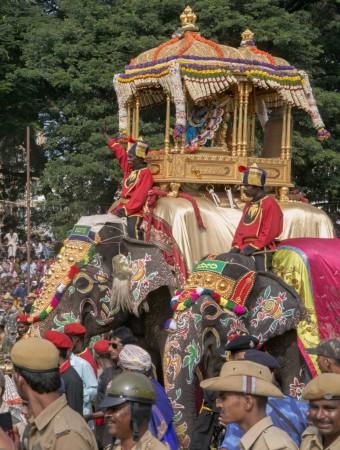
One of the most extravagant festivals in South India has run into trouble with People for Ethical Treatment of Animals (Peta). The animal rights organisation has raised staunch objection against the use of elephants in the festivities of Dasara, a 10-day long celebration that starts with Navaratri and ends with a grand procession through the streets of the culture capital on the day of Vijayadashami.
Four days ahead of World Elephant Day, Peta announced a protest opposing the use of elephants for commercial purposes, processions, performances and circuses.
One of the highlights of the grand Dasara celebration in Mysore is the Jamboo Savari, a procession that covers 5.5 kilometers through the streets of what was once the capital of the erstwhile royal kingdom of Mysore.
The event attracts lakhs of people, not just form across India but from various parts of the globe. Also called 'Nadahabba' or state festival, it truly is a spectacle to behold. If Peta does choose to pursue the issue of elephants being a part of the grand Dasara procession, it might not go down well with the people of Mysore.
While the scale of the celebrations is reason enough to wait for it in anticipation, the Jamboo Savari on the final day has become an integral part of the culture of the grand old city.
A tradition that's 400 years old
Started in the year 1610 by Raja Wodeyar l of the erstwhile kingdom, the Jamboo Savari is an integral part of the extravagance which marks the culmination of the festivities in the culture capital. The most-anticipated of the entire 10-day celebration is a 400-year-old tradition that involves three elephants leading a spectacular procession amid a sea of spectators.
The procession on Vijayadashami covers a distance of 5.5 kilometers, starting from the grand Mysore Palace and ending at Bannimantap, passing through the city of Mysore. The main elephant, Arjuna, carries the Golden Howdah weighing 750 kilos.

Apart from an entourage of horses and camels, the procession is accompanied by the performances of dancers and musicians to entertain thousands of spectators along the way. Vibrant and colourful tableaux too form a part of the procession, showcasing the different cultural aspects of the state.
A robust diet and plenty of exercises
The Mysore dasara is just two months away and the royal palace has begun preparations for the highly-anticipated festival. A key aspect of the preparations is the diet of the elephants.
While the problem with the use of elephants for a celebration as huge and vibrant as the Mysore dasara cannot be denied, it should be noted that the elephants are prepared for the procession for over two months. The three elephants are treated to a steady diet packed with nutrients with the intention of building enough stamina to sustain through the 5.5-kilometer long procession.
From boiled rice, paddy, dal, wheat and ragi to butter, sugar and jaggery, the elephants are also fed 300 to 500 kilos of Banyan and Peepal tree leaves.
This is not the first time concerns over the treatment and use of elephants in the Jamboo Savari have been raised. The care and well-being of these animals is known to have been documented and addressed on multiple occasions. There have been no known reports of abuse or mismanagement of the elephants.

















